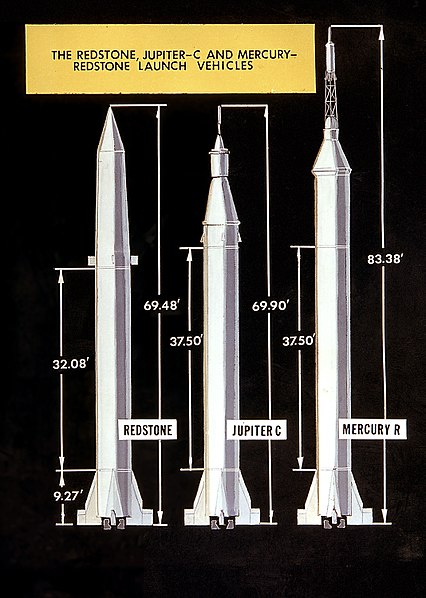Mercury-Redstone Launch Vehicle
The Mercury-Redstone Launch Vehicle, designed for NASA's Project Mercury, was the first American crewed space booster. It was used for six sub-orbital Mercury flights from 1960–1961; culminating with the launch of the first, and 11 weeks later, the second American in space. The four subsequent Mercury human spaceflights used the more powerful Atlas booster to enter low Earth orbit.
Mercury-Redstone 2 launch carrying Ham, a chimpanzee, on 31 January 1961.
Comparison of Mercury-Redstone (right) with Redstone missile and Jupiter-C
Mercury-Redstone prior to test-firing in the Redstone Test Stand at Marshall Space Flight Center, Alabama
MSFC Mercury-Redstone Project Manager Joachim Kuettner (l) and center officials host MR-4 astronaut Gus Grissom (6th from l).
The National Aeronautics and Space Administration is an independent agency of the U.S. federal government responsible for the civil space program, aeronautics research, and space research. Established in 1958, it succeeded the National Advisory Committee for Aeronautics (NACA) to give the U.S. space development effort a distinct civilian orientation, emphasizing peaceful applications in space science. It has since led most of America's space exploration programs, including Project Mercury, Project Gemini, the 1968–1972 Apollo Moon landing missions, the Skylab space station, and the Space Shuttle. Currently, NASA supports the International Space Station along with the Commercial Crew Program, and oversees the development of the Orion spacecraft and the Space Launch System for the lunar Artemis program.
NASA Headquarters in Washington, D.C.
A U.S. Air Force Bell X-1 test flight
Launch of the Army Ballistic Missile Agency's Explorer 1, America's first satellite
Launch of Friendship 7, NASA's first orbital flight, February 20, 1962








